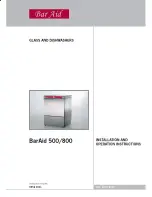
24
OPERATION
3
Refit the cap tightly.
4
Run the
Rinse
cycle without dishes.
Salt Refill Cycle (1 kg for each load)
• The table describes information of
Auto
programme.
• Cycle may vary on the salt refill amount.
CAUTION
• Do not pour any detergent in the salt dispenser.
It will cause a malfunction.
• Wipe off any spilled salt around the salt
dispenser cap. Saline solution that runs into can
cause corrosion in the tub and to the dishwasher
load.
• Seal the cap properly by aligning it horizontally
and turning it clockwise. A loosely fitted cap may
cause the saline solution to leak from the salt
dispenser into the tub and cause corrosion.
• After refilling the dishwasher salt, a wash
programme should be operated without dishes,
as any spilled salt inside the appliance may cause
rust or damage to the appliance if the left
unwashed.
NOTE
• The salt can be purchased from salt distributors.
Adding Rinse Aid
The
Rinse Aid
indicator appears in the display
when more rinse aid is needed.
The use of rinse aid is recommended to prevent
water spots on dishes and to enhance drying
results.
1
Open the rinse aid lid by lifting up the flap.
2
Add a liquid rinse aid to the maximum fill level.
The rinse aid should be settled in the dispenser
while filling, or air bubbles may result in poor
drying results.
3
Close the lid to lock the dispenser. Rinse aid is
dispensed automatically during the final rinse
cycle.
CAUTION
• Wipe off any spilled rinse aid to prevent suds.
NOTE
• Only use liquid rinse aid in the appliance.
• Do not overfill the rinse aid dispenser.
• Too much or too little rinse aid can inhibit the
drying results.
• If rinse aid flows out of the dispenser, wipe it off.
Otherwise many suds can occur and stain the
dishwasher.
H1
H2
H3
H4
Cycles
130
50
20
10
















































